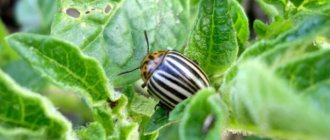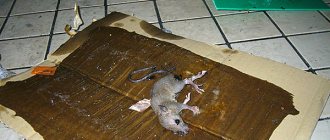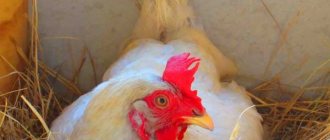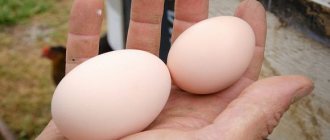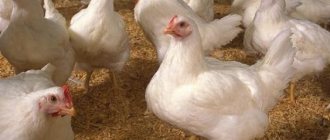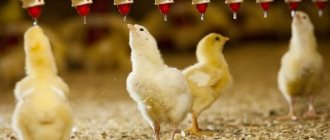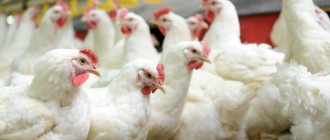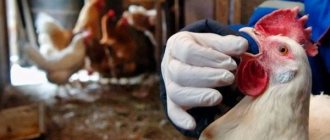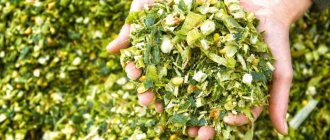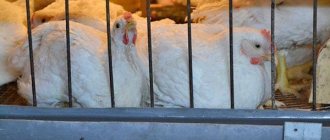2 450
3 comments
4
Author:
Kiva Anatoly.
Reading time: 22 minutes
Since March 2022, the company has been producing an updated line of feed for broilers Purina® Profi. It is intended for full feeding of poultry in personal and farm households. The complex includes three components - “Start”, “Growth” and “Finish”.
When developing an improved feed formulation, emphasis was placed on the following::
- prevention of intestinal diseases, especially coccidiosis;
- uniformity of livestock;
- reducing poultry mortality to a minimum;
- high final broiler weight;
- versatility;
- cost savings on purchasing vaccines and veterinary drugs;
- taste of meat.
Purina® PROFI food contains no growth hormones.
To solve these problems, the composition was introduced:
- butyrates, which maintain normal microflora in the intestines due to the normal growth of intestinal villi, and also strengthen the immunity of broilers;
- phytogenics - to stimulate appetite and maintain a healthy ratio of different bacteria;
- coccidiostat (monensin sodium) – to protect against coccidiosis;
- feed antibiotics (zinc bacitracin) – provide protection against enteritis.
Butyrates and phytogenics are included in all three feeds of the line, coccidiostats and feed antibiotics are included in “Start” and “Growth”.
Catalog
Food is produced in the forms of granules, briquettes and in bulk. The first and second ones retain their taste better, take up less space during operation, but the powder does not require additional grinding.
Purina feed for broilers consists of two product lines: “ECO” and “PRO”.
Both contain mixtures for three stages of growth:
- Starter – 0–14 days.
- Grower – 15–30 days.
- Finisher – 30–60 days.
The lines vary in composition. "ECO" is aimed at households, and "PRO" is aimed at a large farm, and therefore contains additives that accelerate growth and weight gain. For farmers who prepare their own chicken food, Purina produces a protein-vitamin-mineral concentrate (PVMC).
Composition norm for chickens
| Index | Mass fraction, %, for an adult | Mass fraction, %, for young animals and broilers |
| Protein | 45,0 | 48,0 |
| Cellulose | 5,0 | 3,5 |
| Calcium | 4,0 | 4,0 |
| Phosphorus | 1,8 | 2,0 |
| Sodium | 1,0 | 1,0 |
| Lysine | 2,8 | 3,0 |
| Methionine and cystine (total) | 1,7 | 1,8 |
Purina® Profi “Start”
CharacteristicsBasic nutritional indicators
| Broiler age (days) | 0 – 10 |
| Feed consumption for the period (per head/kg) | 0,35 |
| Calorie content (Kcal/100 g) | 295 |
| Compound | cereals; meal; raw materials of animal origin; soybean products; wheat product; grain products; pulses; vegetable oil; protein concentrate; vitamin-mineral premix; amino acids; salt; soda; limestone; choline chloride; macroelements; betaine hydrochloride; coccidiostat; feed antibiotic; phytogenics; granule fixer; antioxidant; enzymes |
| Basic nutritional indicators | The nutritional value | Units |
| Crude protein | 225 | g/kg |
| Crude fat | 25 | g/kg |
| Crude fiber | 38 | g/kg |
| Lysine | 13 | g/kg |
| Methionine + cystine | 9,3 | g/kg |
| Calcium | 8 | g/kg |
| Calcium + enzyme | 9 | g/kg |
| Phosphorus | 4,5 | g/kg |
| Vitamin A | 11500 | IU/kg |
| Vitamin D3 | 3500 | IU/kg |
| Vitamin E | 60 | mg/kg |
Chickens do not require additional vaccination.
The feed already contains the required amount of veterinary drugs, and their excess in case of additional administration will negatively affect both the health of the bird and the final product..
If you still have to contact the veterinarian, be sure to tell him that you are giving the updated food for Purina® PROFI “Start” broilers.
Reviews
Marina Egorova
I have been raising broilers for 10 years.
I believe that it is important to feed broilers correctly in the first days. Purina is a bit expensive. But I always give starter up to seven days. The chickens quickly gain weight and are healthy; if they get sick, it is very rare. Afterwards I make the food myself, but I use a supplement from Purina.
Egorov Pyotr Stepanovich
Farmer, livestock 200 pcs., experience 15 years
A bag of Purina feed is not cheap, but in the end it turns out cheaper than giving other feeds. Every year I select one or two control groups to try and compare different foods. For small chickens, Purina Starter is definitely a winner so far. If, of course, the farm has a dozen birds for itself, then perhaps the difference is not visible, but for a large farm it is very noticeable.
Konstantin Marchenok
Personal farming, 5 years of experience
Not long ago I started farming poultry. I still have a few birds. So, there is more for the family, and there is still some left for sale to friends. I plan to expand. So I started raising broilers. I like Purina Start. The bird is healthy and gaining weight steadily. Chickens don't get sick. I'm thinking of trying the whole line. Otherwise I started with Purina Start, and then mixed the food myself.
Broiler feeding
Below is a brief description of each line of mixtures. The composition is identical, the difference is in the mass fraction.
0–14 days
Starter. Helps the growth and strengthening of the bird's body. The purine mixture is finely ground and therefore suitable for chickens.
Compound:
- Wheat, vegetable oil, sunflower cake, dolomite flour, corn;
- Essential oils;
- Coccidiostatic – a substance that protects birds from internal parasites;
- Enzymes, vitamins.
15–33 days
Corresponds to the Grouer line. Designed for older chickens to help them build muscle mass.
Contains:
- Wheat, corn, sunflower cake, vegetable oil, dolomite flour;
- Enzymes;
- Antioxidants.
The broiler gains weight up to 3 kg.
34–60 days
The Finisher ruler is suitable. This is a constant feed until the broiler is slaughtered.
Contains:
Related publications
Which dog food to choose: what to look for...
Sep 17, 2020
Review of premixes for chickens
May 1, 2020
- Wheat, corn, soybean cake, vegetable oil, dolomite flour;
- Vitamins and minerals;
- Enzymes;
- Antioxidants.
What are premixes
Since the poultry diet consists of 60-70% cereal grains, it must be enriched with amino acids, vitamins, enzyme preparations, antioxidants, microelements and other components. It is difficult to directly introduce such substances into feed mixtures due to their too small amount. The best effect is achieved when administered in the form of ready-made additives.
The pure substance is most similar to meat and bone meal. For uniform dosing, it is mixed with filler.
A premix is a homogeneous mixture of biologically active substances in a filler. At home, bran, crushed wheat, and feed yeast are usually used as filler.
Premixes are most often added to mixed feed in an amount of 1% or 10 kg per ton.
When making them, vitamins and amino acids are first mixed with filler, and then salts of microelements are added.
When choosing biologically active substances, their availability to the bird’s body, the possibility of complete and effective use of the active principle of the drug and the absence of toxicity are taken into account. Microelements are included in the premix by stepwise mixing. Incompatible additives are administered in a stabilized form.
Advantages and disadvantages
Product advantages:
- Efficiency - the chicken gains healthy weight;
- Well digested and absorbed;
- Increases immunity;
- A complete and balanced diet, no need to additionally feed the chickens;
- Absolutely safe.
Disadvantages of the product:
- High price. Regular grain costs half as much. You can try making your own mash, but purina was developed by nutrition experts.
Types of additives
- vitamin (a mixture of vitamin preparations with filler)
- mineral (microelements + filler)
- complex (a mixture of all necessary components, including microelements with filler)
- medicinal (contain drugs in prophylactic and therapeutic doses)
- protein (protein concentrates added to carbohydrate feeds).
Premix recipes are constantly being improved taking into account the latest advances in the field of feeding, the level of productivity of laying hens and broilers and the emergence of new biologically active drugs on the market.
A balanced diet is the key to business profitability.
The best compound feed
The mixture is selected according to the age of the bird.
- Purina for chickens – BR-1 (start). It mainly consists of feed wheat. Contains dolomite flour, cake, salt, vegetable oil. After two weeks of feeding, the chicken’s bones will become stronger and its metabolism will improve.
- Then food PK2–5 is gradually introduced. It is high in calories, high in carbohydrates and protein, because at this stage the birds begin to actively grow.
- After a month, broilers can be fed with a constant mixture - BR-3. The meat from a bird that has eaten this BR-3 will become tasty and healthy.
Important! It is better to buy food only from popular manufacturers who have quality certificates.
Mixtures from little-known companies are cheaper, but they may lack the necessary substances. This will harm the birds.
The cost of purine nutrition is higher than the market average. Eg:
- Purina Start “PRO” - ~ 1000 rub./25 kg; Grower “PRO” – ~1500 RUR/40 kg; Finisher “PRO” - ~1300 RUR/40 kg.
About the brand
Since 2001, all rights to the Purina trademark belong to the Swiss corporation Nestle. The brand was first registered in the USA in 1926 by the company of the same name. In 1979, Purina merged with British dog food and grain products company Spillers.
Under the Purina brand, Nestle produces a wide range of food for a wide variety of animals: from cats and cats to rabbits, cattle and poultry. In total, this division of the company employs about 17,000 employees, and its annual turnover reaches 11 billion US dollars.
The corporation's production facilities are located in many countries around the world, including Russia. The production of brand feed in the Russian Federation is carried out by 4 factories, which are located in the Moscow, Leningrad, Samara and Rostov regions.
Feeding scheme for meat breeds of chickens
| Characteristics | Prestart | Start | Grover | Finish | |
| Age | 0–6 | 7–14 | 16–33 | 34–60 | |
| Gain per day (g) | 15 | 14–34 | 54 | 55–56 | |
| Amount of feed (g) | 20 | 30–90 | 90–130 | 160–170 | |
| Grinding | Finely sifted cereal | Granule diameter – 3 mm | 3.5 mm | ||
| Feeding frequency (once a day) | 8 | 6 | 4 | 2 | |
Important! The drinking bowl should always be filled with fresh water.
Storage conditions
The shelf life of Purina® Profi is 6 months. Food should be stored in a cool, dry place. It is important to prevent it from getting wet, otherwise it should absolutely not be used.
Soaked and dried food is spoiled. Its use can lead to loss of livestock.
How to properly organize a broiler business? Is this activity profitable and what needs to be taken into account?
Read
How to distinguish young broilers from regular chickens?
More details
Rating of the best broiler chickens - top 5 most productive birds for meat and meat and egg production
Look
Review of colored broiler crosses: high meat productivity and good egg production
Further
Raising broilers in cages is a quick way to gain live weight using a small amount of feed
Look
How to determine quality
Nutrition for birds of different ages differs in composition, but these ingredients are irreplaceable:
- Corn is a source of vitamins, magnesium, iron;
- Proteins are proteins that make up 15% of a living organism;
- Vitamins normalize processes within the body;
- Minerals maintain water-salt balance;
- Feed wheat provides the necessary carbohydrates and amino acids;
- Bone meal and chalk contain calcium and build the skeleton.
Quality food is always well digested. Daily weight gain should be normal.
- If a product is selected in a store, then samples are taken from several places and compared: the samples must be homogeneous.
- Pay attention to color, smell, components. There is no mold in a normal mixture. Check for contamination: half a kilo is sifted using a sieve. If more than 20 species of beetles, butterflies, and larvae are found, then the food is not suitable for nutrition.
- The standard humidity is 15%. This is checked by drying the mixture at a temperature of 100–130 degrees for an hour. Compare the initial mass and the weight after drying. The percentage lost is moisture.
- By smell: 30 g of food is poured into a porcelain bowl, covered with glass and immersed in boiling water. After five minutes, check the smell. Mustiness and decomposition should not be felt.
- A bitter taste is a sign of a spoiled product.
Poultry feed markings
Compound feed is a mixed feed intended for feeding farm animals and birds with their level of development and physical need for nutritional, mineral and biological components. All formulations undergo preliminary preparation and processing to increase the calorie content of the finished product. Compound feed is:
- loose;
- expanded;
- expanded-granular.
Expanded feed is a mixture that is obtained as a result of short-term temperature treatment under high pressure. The advantages of this method are as follows:
- liquid substances are introduced in large quantities (oil);
- neutralizes harmful substances;
- improves the quality and digestibility of food products by birds;
- optimal granule structure;
- Cheap raw materials are used for production.
Feeding standards for young animals and laying hens.
During the manufacturing process, the expander reduces the microbial contamination of raw materials - the number of bacteria in one gram of processed raw materials. Bacteria, E. coli, molds and salmonella are completely destroyed. The use of such feed will allow:
- shorten the fattening period;
- reduce poultry mortality;
- increase egg production;
- reduce feed consumption per unit of production;
- reduce automatic losses during transportation and distribution.
Complete ration feeds are produced according to a recipe approved in the prescribed manner, calculated using regulatory documents.
Compound feed for broilers and laying hens is sold in bags or by weight.
| Feed labeling | Bird age |
| PC-0 | 1-4 days |
| PC-1 | Egg breed chicken |
| PC 1-1 | Laying hens up to 45 days |
| PC 1-2 | Over 45 days |
| PC 1-2-3 | Over 45 days |
| PC-2 | Young animals |
| PK-3 | Young chickens 14-17 days |
Egg chickens are fed dry, wet and mixed feeds. Poultry farmers have long debated which food to give preference to. Almost everyone knows the composition of PK-1 feed and chicken coop owners speak positively about it.
PC-1 for laying hens
PC 1-18 is a complete ration feed for brood hens, it is preferable to use chickens from 1 to 2 months old. What dose does a chicken need per day? One laying hen needs up to 50 grams of feed per day.
The composition of feed for laying hens PK 1-2 includes all the necessary amino acids, vitamins, minerals with calcium, which is necessary for all agricultural breeds of birds. Manufacturers have added additives to the feed, which has a great effect on the well-being of chicken. The inactivators included in the composition help with mycotoxicosis.
PC-1 is designed to improve the egg production performance of laying hens. To calculate its quantity, you need to know how much feed a laying hen eats per day: about 120 g of feed per head per day.
Pharmacological properties
Formic acid destroys the cells of bacteria and fungi. Therefore, it is used as a preservative. It can also penetrate through any fat layer.
The hogweed plant causes burns
If we talk about animals and humans, fumes penetrate through the pores under the skin.
Known Properties:
- Pronounced action against Varroa mites and microscopic mites that cause acarapidosis;
- For humans, acid is a moderately dangerous substance that has an irritating effect on the upper respiratory tract, skin and conjunctiva of the eyes;
- Bees will not be affected if all dosages are followed.
The drug works most effectively not in summer, but in autumn.
| Advantage | Flaw |
| High flight range (up to 5 km) | Average productivity (honey, propolis) |
| Dry honey signet | Special attention to the choice of honey plant (see above) |
| Strong immunity | Almost no bee bread |
| No increased aggression | They almost never take early bribes |
| Wax production |
The numbers are the number of Varroa mites shed. Conclusion: for ticks in the fall, treatment with formic acid is carried out twice.
Secrets of making food yourself
It is not necessary to feed chickens with industrial food; food for chicks can be prepared with your own hands. For birds under two weeks of age, suitable food consists of:
- cake - 15%;
- corn grains (ground) - 50%;
- kefir - 12%;
- wheat - 15%;
- barley - 8%.
Feed components
For chickens two weeks old and older, a feed mixture of:
- corn chaff - 48%;
- wheat - 13%;
- yeast, grass, bone meal - 5% of each ingredient;
- cake - 20%;
- feed fat - 4%.
Video - The secret to cooking homemade food for chickens
The main disadvantage of home-cooked food is its short shelf life - it quickly turns sour, and spoiled food should not be given to livestock. Purchased food can remain in the feeder for as long as the chickens need to be satisfied.
Quail nutrition
When breeding quails using Purina feed, the following indicators improve:
- number of eggs laid;
- plumage strength;
- eggshell strength;
- speed of weight gain.
The feed contains grains of corn, wheat and barley, vegetable and animal fats, residues from sunflower processing, phosphorus compounds, limestone and other useful substances.
Using Purina food provides animals with all the necessary substances. They grow quickly and do not get sick. The product can be ordered on the company's official website. Farmers leave positive reviews about this feed.

